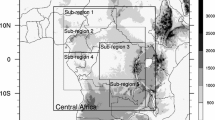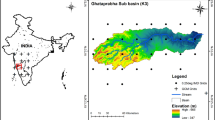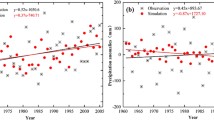Abstract
Algeria is the largest African and Mediterranean country. It is located in the southern seashores of the Mediterranean Sea. Its climate conditions are ranging from relatively wet to very dry which makes it confronted to high levels of rainfall deficits. The future rainfall evolution may be critical for human activities since increased temperatures may further exacerbate droughts and water shortages. In this study, the regional climate simulations RCA4 are evaluated over historical period 1951–2005 and then used to examine the rainfall and temperature projections over the end of the twenty-first century under two Representative Concentration Pathway (RCP4.5 and RCP8.5) scenarios. The historical simulations are evaluated against observations coming from the recent data sets of Climatic Research Unit (CRU). The trends in precipitation and temperature over historical (1951–2005) and projected future scenarios (2006–2060 and 2045–2100) was depicted by the estimation of the shifts of the three main climate zones existing in Algeria (Köppen-Gieger classification): warm temperate climates (C), steppe climate (BS), and desert climate (BW). Comparative to the mean climate zone surface areas derived from observations (1951–2005), all model simulations predict an expansion of desert climate zone at the expense of the temperate and steppe climate zones. This shift seems to particularly increase by the end of twenty-first century (2045–2100) under RCP8.5 scenario.
Access this chapter
Tax calculation will be finalised at checkout
Purchases are for personal use only
Similar content being viewed by others
References
Williams JW, Jackson ST, Kutzbach JE (2007) Projected distributions of novel and disappearing climates by 2100 AD. Proc Natl Acad Sci U S A 104(14):5738–5742
Folland CK, Karl TR, Christy JR, Clarke RA, Gruza GV, Jouzel J, Mann ME, Oerlemans J, Salinger MJ, Wang S-W (2001) Chapter 2: observed climate variability and change. In: Climate change 2001: the scientific basis. Cambridge University Press, Cambridge, pp 99–182
Lionello P, Malanotte-Rizzoli P, Boscolo R, Alpert P, Artale V, Li L, Luterbacher J, May W, Trigo R, Tsimplis M, Ulbrich U, Xoplaki E (2006) The Mediterranean climate: an overview of the main characteristics and issues. Dev Earth Environ Sci 4(C):1–26
Bolle H-J (2003) Mediterranean climate: variability and trends. Springer, Berlin
Driouech F, Déqué M, Mokssit A (2008) Numerical simulation of the probability distribution function of precipitation over Morocco. Climate Dynam 32(7–8):1055–1063
Christensen JH, Hewitson B, Busuioc A, Chen A, Gao X, Held R et al (2007) Regional climate projections. Climate change, 2007: the physical science basis. Contribution of Working Group I to the fourth assessment report of the intergovernmental panel on climate change, vol 11. Cambridge University Press, Cambridge, pp 847–940
Giorgi F, Jones C, Asrar GR (2009) Addressing climate information needs at the regional level: the CORDEX framework. Bull World Meteorol Organ 58(3):175–183
Kalognomou EA, Lennard C, Shongwe M, Pinto I, Favre A, Kent M, Hewitson B, Dosio A, Nikulin G, Panitz HJ, Büchner M (2013) A diagnostic evaluation of precipitation in CORDEX models over Southern Africa. J Climate 26(23):9477–9506
Köppen W (1936) Das geographisca System der Klimate. In: Koppen W, Geiger G, Gebr C (eds) Handbuch der Klimatologie. Borntraeger, Berlin, pp 1–44
Tanarhte M, Hadjinicolaou P, Lelieveld J (2012) Intercomparison of temperature and precipitation data sets based on observations in the Mediterranean and the Middle East. J Geophys Res 117:D12
Jones C, Giorgi F, Asrar G (2011) The Coordinated Regional Downscaling Experiment: CORDEX–an international downscaling link to CMIP5. Clivar Exch 56:34–40
Nikulin G, Jones C, Giorgi F, Asrar G, Büchner M, Cerezo-Mota R, Christensen OB, Déqué M, Fernandez J, Hänsler A, Van Meijgaard E, Samuelsson P, Sylla MB, Sushama L (2012) Precipitation climatology in an ensemble of CORDEX-Africa regional climate simulations. J Climate 25(18):6057–6078
IPCC Working Group 1 et al (2013) IPCC, 2013: Climate change (2013): the physical science basis. Contribution of Working Group I to the fifth assessment report of the intergovernmental panel on climate change, IPCC, vol AR5, p 1535
IPCC (2013) Working Group I contribution to the IPCC fifth assessment report, climate change 2013: the physical science basis, IPCC, vol AR5, March 2013, p 2014
Schulzweida U, Kornblueh L, Quast R (2007) CDO user’s guide, Climate Data Operators
Sennikovs J, Bethers U (2009) Statistical downscaling method of regional climate model results for hydrological modelling. 18th World IMACS/MODSIM Congress, Cairns, Australia, 13–17 July
Nguyen H, Mehrotra R, Sharma A (2017) Can the variability in precipitation simulations across GCMs be reduced through sensible bias correction? Climate Dynam 49:1–19
Kottek M, Grieser J, Beck C, Rudolf B, Rubel F (2006) World map of the Köppen-Geiger climate classification updated. Meteorol Z 15(3):259–263
Peel BL, Finlayson BL, McMahon TA (2007) Updated world map of the Koppen-Geiger climate classification. Hydrol Earth Syst Sci 11:1633–1644
Zeroual A, Assani AA, Meddi M, Alkama R (2019) Assessment of climate change in Algeria from 1951 to 2098 using the Köppen–Geiger climate classification scheme. Climate Dynam 52(1–2):227–243
Giorgi F (2002) Variability and trends of sub-continental scale surface climate in the twentieth century. Part II: AOGCM simulations. Climate Dynam 18(8):693–708
New M, Todd M, Hulme M, Jones P (2001) Precipitation measurements and trends in the twentieth century. Int J Climatol 21:1899–1922
Zeroual A, Assani A, Meddi M (2017) Combined analysis of temperature and rainfall variability as they relate to climate indices in Northern Algeria over the 1972–2013 period. Hydrol Res 48(2):584–595
Philandras CM, Nastos PT, Kapsomenakis IN, Repapis CC (2015) Climatology of upper air temperature in the Eastern Mediterranean region. Atmos Res 152:29–42
Driouech F (2006) Étude des indices de changements climatiques sur le Maroc: températures et précipitations. Direction de la Meteorologie Nationale ‘INFOMET’, Casablanca
Ramadan HH, Beighley RE, Ramamurthy AS (2013) Temperature and precipitation trends in Lebanon’s largest river: the Litani Basin. J Water Resour Plan Manag 139(1):86–95
Norrant C, Douguédroit A (2006) Monthly and daily precipitation trends in the Mediterranean (1950–2000). Theor Appl Climatol 83(1–4):89–106
Tramblay Y, El Adlouni S, Servat E (2013) Trends and variability in extreme precipitation indices over Maghreb countries. Nat Hazards Earth Syst Sci 13(12):3235–3248
Stocker T, Qin D, Plattner G, and Tignor M (2013) Climate change 2013: the physical science basis. Contribution of working group I to the fifth assessment report of the intergovernmental panel
Raymond F, Ullmann A, Camberlin P (2016) Précipitations intenses sur le Bassin Méditerranéen: quelles tendances entre 1950 et 2013? Cybergeo Eur J Geogr 760:8504
Acknowledgment
The authors acknowledge the use of temperature and precipitation gridded data from both the Climatic Research Unit (CRU) and the RCA4 regional climate model of Rossby Centre (SMHI).
Conflict of Interest
The authors declare that they have no conflict of interest.
Author information
Authors and Affiliations
Corresponding author
Editor information
Editors and Affiliations
Rights and permissions
Copyright information
© 2020 Springer Nature Switzerland AG
About this chapter
Cite this chapter
Zeroual, A., Assani, A.A., Meddi, H., Bouabdelli, S., Zeroual, S., Alkama, R. (2020). Assessment of Projected Precipitations and Temperatures Change Signals over Algeria Based on Regional Climate Model: RCA4 Simulations. In: Negm, A.M., Bouderbala, A., Chenchouni, H., Barceló, D. (eds) Water Resources in Algeria - Part I. The Handbook of Environmental Chemistry, vol 97. Springer, Cham. https://doi.org/10.1007/698_2020_526
Download citation
DOI: https://doi.org/10.1007/698_2020_526
Published:
Publisher Name: Springer, Cham
Print ISBN: 978-3-030-57894-7
Online ISBN: 978-3-030-57895-4
eBook Packages: Chemistry and Materials ScienceChemistry and Material Science (R0)




